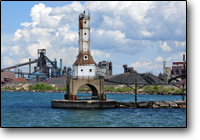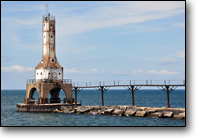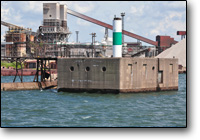Historical Information
As
the nineteenth century drew to a close, Chicago’s industries were
suffering congested freight conditions in the city streets, rail
connections and harbor. For those industries wishing to expand or
relocate within the city, skyrocketing land values served as an
insurmountable challenge to many. A group of investors operating under
the name of the Chicago Land Company saw the situation as advantageous
to their interests, and began buying up large tracts of land in the
area of East Chicago some seventeen miles east of the Windy City where
they planned on establishing a major industrial complex. Controlled by
Chicago real estate barons Aldis, Aldis & Northcote with the
backing of Henry Clay Frick of the Carnegie Steel Company and New York
banker J. Kennedy Tod, the group had dreams of creating a first class
harbor with connections to the rail lines which passed along the south
shore and of constructing a canal to connect the harbor to the Calumet
River and the Mississippi beyond.Realizing that
they needed an anchor industry to attract new development, the Land
Company came up with a gutsy proposal whereby they offered to provide
fifty acres of free land to any steel company which would erect a
facility with a minimum value of a million dollars in the new harbor.
Formed in 1893 after purchasing the idle machinery of Chicago Steel
Works in Chicago Heights, Inland Steel Company had grown to a level of
$350,000 in sales in 1897, and by 1901 found itself outgrowing its
existing facilities and found itself in a financial position in which
the Chicago Land Company’s offer proved extremely attractive. Even
though, at that point, the new “harbor” consisted largely of unimproved
land among the sand dunes. 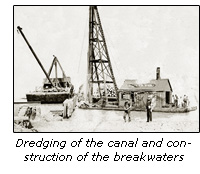 With Inland Steel
now on board to serve as their anchor industry and a conviction that
related industries would soon follow, in 1901 the Chicago Land Company
entered into a $200,000 contract with Chicago marine contractor Hausler
& Lutz to dredge and erect breakwaters for what would eventually
become known as Indiana Harbor. By the following year, Inland Steel had
completed construction of the first phase of its new plant, and was
operating in the harbor.In 1903, the Chicago
Land Company reorganized under the name of The East Chicago Company.
With this reorganization, the assets of the Standard Steel and Iron
Company, Lake Michigan Land Company and the Calumet Canal Improvement
Company were consolidated, provided direct control of over 7,000 acres
of land in Indiana Harbor, East Chicago and Hammond. After considerable
“speechifying” by such dignitaries as Senator Charles Warren Fairbanks,
Congressmen Charles B. Landis and Congressman Edgar D. Crumpacker,
Indiana Governor Winfield T. Durbin ceremonially pressed an electric
button on October 24, 1903 which sent two monster dredges into action
at the lake end of the new canal which would connect the harbor to the
Calumet River, some 3 miles to the south. With Inland Steel
now on board to serve as their anchor industry and a conviction that
related industries would soon follow, in 1901 the Chicago Land Company
entered into a $200,000 contract with Chicago marine contractor Hausler
& Lutz to dredge and erect breakwaters for what would eventually
become known as Indiana Harbor. By the following year, Inland Steel had
completed construction of the first phase of its new plant, and was
operating in the harbor.In 1903, the Chicago
Land Company reorganized under the name of The East Chicago Company.
With this reorganization, the assets of the Standard Steel and Iron
Company, Lake Michigan Land Company and the Calumet Canal Improvement
Company were consolidated, provided direct control of over 7,000 acres
of land in Indiana Harbor, East Chicago and Hammond. After considerable
“speechifying” by such dignitaries as Senator Charles Warren Fairbanks,
Congressmen Charles B. Landis and Congressman Edgar D. Crumpacker,
Indiana Governor Winfield T. Durbin ceremonially pressed an electric
button on October 24, 1903 which sent two monster dredges into action
at the lake end of the new canal which would connect the harbor to the
Calumet River, some 3 miles to the south.  Indiana
Harbor was becoming a reality, and a number of other industries began
construction of new facilities there, with American Steel Foundries and
the Buckeye Steel Castings Companies among the first and largest. In
order to add more industrial space around the harbor, at the request of
the East Chicago Company, the mills began dumping their slag into Lake
Michigan, and with the addition of fill brought out from the mainland,
a continuing process of northward expansion of the harbor was underway.With
construction of the canal ongoing, the East Chicago Company began
lobbying for federal maintenance and improvement of Indiana Harbor.
Heeding the call of his influential constituent industries, Indiana
Congressman Edgar D. Crumpacker of Valparaiso quickly introduced a
number of bills calling for the federal government to take over
improvement of the harbor. Among these, House Bill 10447 called for the
establishment of a federal lighthouse to guide vessels into the harbor.
The bill was referred to the Committee on Interstate and Foreign
Commerce, and then relegated to the Subcommittee on the Lighthouse
Establishment, where it was finally discussed on January 16, 1905. With
consideration concurrently under evaluation as to whether the Army
Corps of Engineers should assume responsibility for the harbor, it was
agreed that if and when the harbor were to become a federal
responsibility then lighting the piers and breakwaters would be vitally
necessary. However, until that time no federal action would be taken. Indiana
Harbor was becoming a reality, and a number of other industries began
construction of new facilities there, with American Steel Foundries and
the Buckeye Steel Castings Companies among the first and largest. In
order to add more industrial space around the harbor, at the request of
the East Chicago Company, the mills began dumping their slag into Lake
Michigan, and with the addition of fill brought out from the mainland,
a continuing process of northward expansion of the harbor was underway.With
construction of the canal ongoing, the East Chicago Company began
lobbying for federal maintenance and improvement of Indiana Harbor.
Heeding the call of his influential constituent industries, Indiana
Congressman Edgar D. Crumpacker of Valparaiso quickly introduced a
number of bills calling for the federal government to take over
improvement of the harbor. Among these, House Bill 10447 called for the
establishment of a federal lighthouse to guide vessels into the harbor.
The bill was referred to the Committee on Interstate and Foreign
Commerce, and then relegated to the Subcommittee on the Lighthouse
Establishment, where it was finally discussed on January 16, 1905. With
consideration concurrently under evaluation as to whether the Army
Corps of Engineers should assume responsibility for the harbor, it was
agreed that if and when the harbor were to become a federal
responsibility then lighting the piers and breakwaters would be vitally
necessary. However, until that time no federal action would be taken.
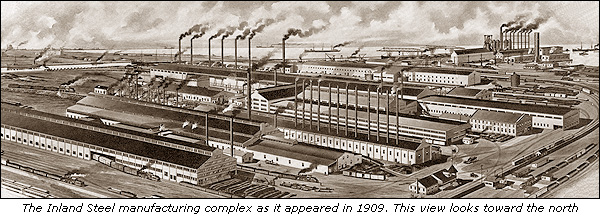
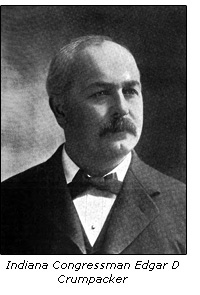 Finally
in 1910, Crumpackers’ continued efforts on behalf of the East Chicago
Company bore fruit. With the passage of the Rivers and Harbors Act of
June 25, 1910, the federal government assumed responsibility for the
long term maintenance and improvement of Indiana Harbor. With an
initial appropriation of $62,000, the Army Corps of Engineers entered
into a contract with the Great Lakes Sock and Dredge Company to enlarge
the harbor and increase the width of the canal to 300 feet and the
depth to 20 feet throughout. Work began in April of 1911, and by July
the dredging had progressed to the point that a number of large vessels
with drafts of 18 and 19 feet had gained entry through the new channel.
Thus, with federal involvement in the project a done deal, Commissioner
George R. Putnam of the fledgling Bureau of Lighthouses had no
alternative but to turn his attention to lighting the entry into the
harbor. However, since the Army Corps improvements at Indiana Harbor
were as yet unfinished, and it had as yet been determined exactly how
far the breakwaters would extend into the lake, the decision was made
to start small, and improve over time. Finally
in 1910, Crumpackers’ continued efforts on behalf of the East Chicago
Company bore fruit. With the passage of the Rivers and Harbors Act of
June 25, 1910, the federal government assumed responsibility for the
long term maintenance and improvement of Indiana Harbor. With an
initial appropriation of $62,000, the Army Corps of Engineers entered
into a contract with the Great Lakes Sock and Dredge Company to enlarge
the harbor and increase the width of the canal to 300 feet and the
depth to 20 feet throughout. Work began in April of 1911, and by July
the dredging had progressed to the point that a number of large vessels
with drafts of 18 and 19 feet had gained entry through the new channel.
Thus, with federal involvement in the project a done deal, Commissioner
George R. Putnam of the fledgling Bureau of Lighthouses had no
alternative but to turn his attention to lighting the entry into the
harbor. However, since the Army Corps improvements at Indiana Harbor
were as yet unfinished, and it had as yet been determined exactly how
far the breakwaters would extend into the lake, the decision was made
to start small, and improve over time.
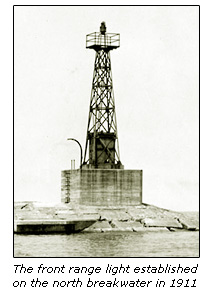 As such, the
first federal navigation aids erected at Indiana Harbor in 1911 took
the form of a pair of prefabricated black skeletal iron range lights
with a small enclosed shed within their bases. The Front Range light
was located at the outer end of the rubble mound north breakwater with
its light standing 17 feet above the concrete surface. The rear range
structure stood 615 feet to shoreward on the same breakwater, its light
standing 27 feet above the base. Both lights were illuminated by
acetylene gas which was stored in cylinders located in the small
enclosed shed at their bases, and outfitted with sun valves which
automatically turned the lights on each day at dusk and off at dawn.
Typical of such acetylene-powered structures, they incorporated a flash
mechanism which caused the lights to flash for a very short duration,
thereby reducing the consumption of the gas. Exhibited for the first
time on the night of September 15th, the Front Range light exhibited a
single flash of 0.3 seconds every second and the rear range a flash of
1 second duration followed by a 2 second eclipse. With
the Army Corps of Engineers construction of rubble mound breakwaters
ongoing, the Lighthouse Bureau determined that on completion of the
current phase of the project the harbor would be deserving of a
significantly larger aid to navigation, and requested an appropriation
of $100,000 to fund the project in 1916. As such, the
first federal navigation aids erected at Indiana Harbor in 1911 took
the form of a pair of prefabricated black skeletal iron range lights
with a small enclosed shed within their bases. The Front Range light
was located at the outer end of the rubble mound north breakwater with
its light standing 17 feet above the concrete surface. The rear range
structure stood 615 feet to shoreward on the same breakwater, its light
standing 27 feet above the base. Both lights were illuminated by
acetylene gas which was stored in cylinders located in the small
enclosed shed at their bases, and outfitted with sun valves which
automatically turned the lights on each day at dusk and off at dawn.
Typical of such acetylene-powered structures, they incorporated a flash
mechanism which caused the lights to flash for a very short duration,
thereby reducing the consumption of the gas. Exhibited for the first
time on the night of September 15th, the Front Range light exhibited a
single flash of 0.3 seconds every second and the rear range a flash of
1 second duration followed by a 2 second eclipse. With
the Army Corps of Engineers construction of rubble mound breakwaters
ongoing, the Lighthouse Bureau determined that on completion of the
current phase of the project the harbor would be deserving of a
significantly larger aid to navigation, and requested an appropriation
of $100,000 to fund the project in 1916. 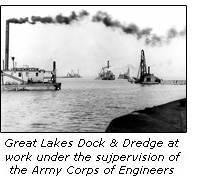 The
United States declaration of war on Germany on April 6, 1917 had an
incredible impact on the development of Indiana Harbor. The sudden
surge in military production brought huge contracts to the industries
around the harbor, with all working at full capacity to satisfy demand.
With a seemingly endless parade of freighters loaded with iron ore from
the mines on Lake Superior and limestone from the quarries on Lakes
Huron and Michigan making their way into the harbor, the Corps of
Engineers realized that the rubble mound breakwaters were becoming
obsolete, and needed to be replaced with structures of a greater degree
of permanence. As such, plans for the new lighthouse were placed
on the back burner until the new permanent piers were erected. The
United States declaration of war on Germany on April 6, 1917 had an
incredible impact on the development of Indiana Harbor. The sudden
surge in military production brought huge contracts to the industries
around the harbor, with all working at full capacity to satisfy demand.
With a seemingly endless parade of freighters loaded with iron ore from
the mines on Lake Superior and limestone from the quarries on Lakes
Huron and Michigan making their way into the harbor, the Corps of
Engineers realized that the rubble mound breakwaters were becoming
obsolete, and needed to be replaced with structures of a greater degree
of permanence. As such, plans for the new lighthouse were placed
on the back burner until the new permanent piers were erected.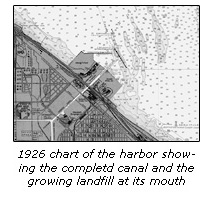 With
an appropriation of $200,000 in hand, the Army Corps of Engineers
advertised for bids in July 1919 to rebuild the east breakwater in
concrete and to erect a foundation for the new lighthouse atop a timber
crib in accordance with plans developed by the Bureau of Lighthouses.
On August 21, 1919, the contract for the work was awarded to the Great
Lakes Dredge and Dock Company, with the company’s equipment working in
the harbor soon thereafter. The work moved ahead quickly, as
prefabricated concrete caissons cast at an Army Corps facility on the
waterfront in Milwaukee were used in building the breakwater,
eliminating the need for casting them locally or in place on the
breakwater. By July 1920, 810 feet of the planned 3,024 feet of East
Breakwater was complete, and the lighthouse crib was virtually finished
with the exception of steel ice sheathing. With
an appropriation of $200,000 in hand, the Army Corps of Engineers
advertised for bids in July 1919 to rebuild the east breakwater in
concrete and to erect a foundation for the new lighthouse atop a timber
crib in accordance with plans developed by the Bureau of Lighthouses.
On August 21, 1919, the contract for the work was awarded to the Great
Lakes Dredge and Dock Company, with the company’s equipment working in
the harbor soon thereafter. The work moved ahead quickly, as
prefabricated concrete caissons cast at an Army Corps facility on the
waterfront in Milwaukee were used in building the breakwater,
eliminating the need for casting them locally or in place on the
breakwater. By July 1920, 810 feet of the planned 3,024 feet of East
Breakwater was complete, and the lighthouse crib was virtually finished
with the exception of steel ice sheathing. 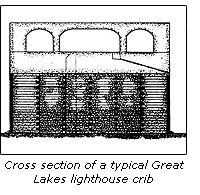 All
told, construction of the timber lighthouse crib required the removal
of 785 cubic yards of lake bed to create a solid base on which to sink
the timber crib. Construction of the crib itself took 196,719 board
feet of lumber shipped in by train from the west coast, 32,633 pounds
of iron and steel, and 2,691 tons of stone to fill the pockets in the
crib. Located 25 feet from the breakwater, the crib was connected to
the breakwater by an iron and steel overhead walkway. Large rooms cast
within the concrete foundation on the crib would serve to house the
station’s full compliment of compressors, generators and heating plant.
Other areas within this structure would serve as storage space for the
supplies required to operate the mechanical systems, such as diesel
fuel and gasoline.Even though the lighthouse
structure itself remained to be built, the Bureau considered activating
the station to be of a sufficiently high priority that the complete fog
signal plant was installed and placed into operation and a temporary
light displayed from an “unpainted post” on the crib standing at a
height of 58 feet above the water – the identical focal plane of the
planned permanent structure. Thus, the new Indiana Harbor East
Breakwater light was exhibited for the first time late in 1920. All
told, construction of the timber lighthouse crib required the removal
of 785 cubic yards of lake bed to create a solid base on which to sink
the timber crib. Construction of the crib itself took 196,719 board
feet of lumber shipped in by train from the west coast, 32,633 pounds
of iron and steel, and 2,691 tons of stone to fill the pockets in the
crib. Located 25 feet from the breakwater, the crib was connected to
the breakwater by an iron and steel overhead walkway. Large rooms cast
within the concrete foundation on the crib would serve to house the
station’s full compliment of compressors, generators and heating plant.
Other areas within this structure would serve as storage space for the
supplies required to operate the mechanical systems, such as diesel
fuel and gasoline.Even though the lighthouse
structure itself remained to be built, the Bureau considered activating
the station to be of a sufficiently high priority that the complete fog
signal plant was installed and placed into operation and a temporary
light displayed from an “unpainted post” on the crib standing at a
height of 58 feet above the water – the identical focal plane of the
planned permanent structure. Thus, the new Indiana Harbor East
Breakwater light was exhibited for the first time late in 1920.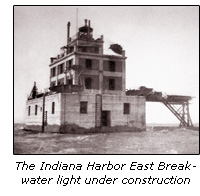 With
funding for completion of the lighthouse finally available in late
1922, work began on the superstructure of the station proper. The new
rectangular building which was erected on the crib served both as a
means for elevating the light and as a dwelling for the station’s
planned compliment of three keepers. Designed in a manner similar to
skyscrapers of the day, an inner framework of steel beams supported
concrete walls and floors and steel stairways. Brick accent areas
surrounding the relatively large steel-framed windows gave the
otherwise austere exterior appearance of the structure a touch of
visual warmth. Centered atop this main structure, a square combination
watchroom and service room supported a circular steel and iron lantern
with helical astragals. As was common with the majority of Great Lakes
lighthouses, the lantern was sized to accommodate a Fourth Order
Fresnel lens, and in order to cause the light to stand out effectively
among the numerous lights of the steel mills along shore, the lens was
equipped with bull’s eyes. Rotation of the lens caused the light to
exhibit a flash as the bulls eyes passed between the light source of
the observer, and created the station’s identifiable characteristic of
a fixed white light with two bright white flashes every 20 seconds.
With construction complete, and all systems in place, James C
Peiterson, the station’s first keeper, made his way up to the lantern
to exhibit the light of the completed Indiana Harbor East Breakwater
Light for the first time on the night of July 14, 1924.Evidently
life at the lighthouse for Peiterson and his two assistants Arthur S.
Almquist and Henry S. Means, must have been relatively uneventful, as
little has been recorded about their lives at the station, either in
government records or in the local newspapers at either Hammond of
Gary. With
funding for completion of the lighthouse finally available in late
1922, work began on the superstructure of the station proper. The new
rectangular building which was erected on the crib served both as a
means for elevating the light and as a dwelling for the station’s
planned compliment of three keepers. Designed in a manner similar to
skyscrapers of the day, an inner framework of steel beams supported
concrete walls and floors and steel stairways. Brick accent areas
surrounding the relatively large steel-framed windows gave the
otherwise austere exterior appearance of the structure a touch of
visual warmth. Centered atop this main structure, a square combination
watchroom and service room supported a circular steel and iron lantern
with helical astragals. As was common with the majority of Great Lakes
lighthouses, the lantern was sized to accommodate a Fourth Order
Fresnel lens, and in order to cause the light to stand out effectively
among the numerous lights of the steel mills along shore, the lens was
equipped with bull’s eyes. Rotation of the lens caused the light to
exhibit a flash as the bulls eyes passed between the light source of
the observer, and created the station’s identifiable characteristic of
a fixed white light with two bright white flashes every 20 seconds.
With construction complete, and all systems in place, James C
Peiterson, the station’s first keeper, made his way up to the lantern
to exhibit the light of the completed Indiana Harbor East Breakwater
Light for the first time on the night of July 14, 1924.Evidently
life at the lighthouse for Peiterson and his two assistants Arthur S.
Almquist and Henry S. Means, must have been relatively uneventful, as
little has been recorded about their lives at the station, either in
government records or in the local newspapers at either Hammond of
Gary.  America’s steel manufacturers were
now supplying the world. The complex of steel mills and ancillary
industries located around Indiana Harbor continued their northward
expansion into the lake, and as the land mass around the harbor grew,
the entrance to the harbor moved northward and westward with it. While
the Army Corps of Engineers continued extending the east breakwater
northward so that it continued to adequately serve the harbor entry,
the massive lighthouse and its crib now found themselves situated far
from the outer end of the elongated breakwater. With land now pushing
ever closer toward the side of the breakwater inland of the lighthouse,
virtually all of the breakwater landward of the lighthouse was removed,
allowing easier access to the industrial facilities to the north. As
such, the lighthouse now served to mark the inner end of the
breakwater, with the outer end unlighted. America’s steel manufacturers were
now supplying the world. The complex of steel mills and ancillary
industries located around Indiana Harbor continued their northward
expansion into the lake, and as the land mass around the harbor grew,
the entrance to the harbor moved northward and westward with it. While
the Army Corps of Engineers continued extending the east breakwater
northward so that it continued to adequately serve the harbor entry,
the massive lighthouse and its crib now found themselves situated far
from the outer end of the elongated breakwater. With land now pushing
ever closer toward the side of the breakwater inland of the lighthouse,
virtually all of the breakwater landward of the lighthouse was removed,
allowing easier access to the industrial facilities to the north. As
such, the lighthouse now served to mark the inner end of the
breakwater, with the outer end unlighted.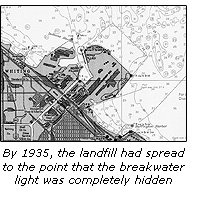 This
problem was further exacerbated by the fact that with the man-made land
growing by leaps and bounds to the north, the light became virtually
hidden by the land and increasingly difficult for mariners to see from
the lake. In order to make the structure noticeable, floodlights were
installed on all four sides of the structure in 1931, but the effort
was futile. The Bureau of Lighthouses was forced to face the
realization that due to its construction and massive size, there was no
way the lighthouse could be relocated to the end of the breakwater. The
only option was to replace the expensive structure a scant decade after
it had been established.By the early 1930’s,
advances in the reliability of both illumination and diaphone fog
signal systems had reached the point that virtually unattended
lighthouses were becoming a reality. Thus the possibility of reducing
the manpower required through the establishment of an automated system
on the extended breakwater was particularly attractive. Also at this
time, Lighthouse Bureau engineers F. P. Dillon and W. G. Will had been
working on a modular design for breakwater and pierhead beacons for use
on the Great Lakes. This
problem was further exacerbated by the fact that with the man-made land
growing by leaps and bounds to the north, the light became virtually
hidden by the land and increasingly difficult for mariners to see from
the lake. In order to make the structure noticeable, floodlights were
installed on all four sides of the structure in 1931, but the effort
was futile. The Bureau of Lighthouses was forced to face the
realization that due to its construction and massive size, there was no
way the lighthouse could be relocated to the end of the breakwater. The
only option was to replace the expensive structure a scant decade after
it had been established.By the early 1930’s,
advances in the reliability of both illumination and diaphone fog
signal systems had reached the point that virtually unattended
lighthouses were becoming a reality. Thus the possibility of reducing
the manpower required through the establishment of an automated system
on the extended breakwater was particularly attractive. Also at this
time, Lighthouse Bureau engineers F. P. Dillon and W. G. Will had been
working on a modular design for breakwater and pierhead beacons for use
on the Great Lakes.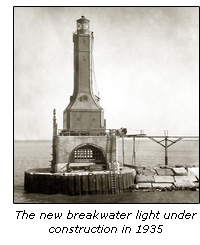 Incorporating
prefabricated cast iron and steel components, these inexpensive $35,000
structures stood approximately 40 feet tall from base to lantern, and
were designed to be relatively easy to erect and disassemble if
required. With plans already in place to install three of these new
structures at Conneaut and Huron Harbors on Lake Erie, and on the new
concrete breakwater at Port Washington, the decision was made to order
an additional set of components for use at the outer end of the
breakwater at Indiana Harbor. As was the case
at Port Washington, the structure at Indiana Harbor was erected atop a
large elevated concrete pier with arched openings in order to increase
its focal plane to 78 feet. This new East Breakwater light was erected
and exhibited for the first time in 1935. In order to provide safe
access to keepers along the breakwater when making their way from the
old lighthouse to the new one when storm-driven waves were crashing
across its surface, an iron and steel elevated walkway was erected on
the breakwater, and the new light was built and exhibited in 1935. Incorporating
prefabricated cast iron and steel components, these inexpensive $35,000
structures stood approximately 40 feet tall from base to lantern, and
were designed to be relatively easy to erect and disassemble if
required. With plans already in place to install three of these new
structures at Conneaut and Huron Harbors on Lake Erie, and on the new
concrete breakwater at Port Washington, the decision was made to order
an additional set of components for use at the outer end of the
breakwater at Indiana Harbor. As was the case
at Port Washington, the structure at Indiana Harbor was erected atop a
large elevated concrete pier with arched openings in order to increase
its focal plane to 78 feet. This new East Breakwater light was erected
and exhibited for the first time in 1935. In order to provide safe
access to keepers along the breakwater when making their way from the
old lighthouse to the new one when storm-driven waves were crashing
across its surface, an iron and steel elevated walkway was erected on
the breakwater, and the new light was built and exhibited in 1935. 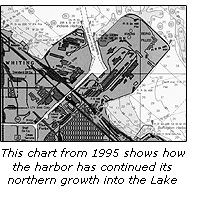 The
light in the old structure was electrified and downgraded to a 2,600
candlepower green 300 mm optic and renamed the “Indiana Harbor East
Breakwater Inner light.” In this guise it continued to serve as the
dwelling for the keepers of the harbor lights through the end of the
days of the Bureau of Lighthouses and after the Coast Guard assumed
responsibility for the nation’s aids to navigation in 1939. The Coast
Guard continued to use the structure until 1970 when the building was
largely abandoned. At this time the station’s light was further
downgraded to 1,100 candlepower and renamed the “Indiana Harbor Light
5,” reflecting its new status as a minor aid to navigation within the
harbor.Likely costing too much to maintain, and
perhaps serving as an attractive nuisance, the superstructure of the
lighthouse was demolished at some time in the mid 1980’s, leaving only
the concrete crib and walkway which connected the structure to the
breakwater. In order to allow it to continue to serve as a harbor aid,
a white cylindrical “D9” tower with horizontal green band was erected
on the crib, and today emits a green flash every 2.5 seconds. The
light in the old structure was electrified and downgraded to a 2,600
candlepower green 300 mm optic and renamed the “Indiana Harbor East
Breakwater Inner light.” In this guise it continued to serve as the
dwelling for the keepers of the harbor lights through the end of the
days of the Bureau of Lighthouses and after the Coast Guard assumed
responsibility for the nation’s aids to navigation in 1939. The Coast
Guard continued to use the structure until 1970 when the building was
largely abandoned. At this time the station’s light was further
downgraded to 1,100 candlepower and renamed the “Indiana Harbor Light
5,” reflecting its new status as a minor aid to navigation within the
harbor.Likely costing too much to maintain, and
perhaps serving as an attractive nuisance, the superstructure of the
lighthouse was demolished at some time in the mid 1980’s, leaving only
the concrete crib and walkway which connected the structure to the
breakwater. In order to allow it to continue to serve as a harbor aid,
a white cylindrical “D9” tower with horizontal green band was erected
on the crib, and today emits a green flash every 2.5 seconds.
One
can only wonder how many of the mariners who pass this light today have
the slightest inkling of the original purpose of that huge concrete
crib on which it sits.

Seeing this Light
Because
the lighthouse and old crib are located on a
private breakwater, and there are numerous large
buildings between any public access areas and the
lighthouse, the lights are virtually impossible to
see from the
land. Either a private boat or a vessel chartered from a local
fisherman
represent the only opportunitis to obtain a good view of this light.
Both the Great Lakes Lighthouse Keepers Association and the United
States Lighthouse Society offer infrequent tours of the suth end of
Lake Michigan, both of which have always provided great close-up views
of this and the other lighthouses of the area. GPS Coordinates
Original 1924 lighthouse crib: 41°40'27.41"N x 87°26'19.64"W
1935 Lighthouse: 41°40'50.88"N x 87°26'27.99"W
Reference sourcesNew York Times newspaper articles, various
The Railway Age, Vol 31, 1901
Chicago Securities, The Chicago Directory Company, 1905.
Annual reports of the Lighthouse Board, various
Annual reports of the Lake Carriers Association, various
Astandard History of Lake County, Lewis Publishing Company, 1915
Annual Reports of the Department of COmmerce, various
Hammond Times newspaper articles, various
A Guide to the Hoosier State, Teachers College, 1941
|
